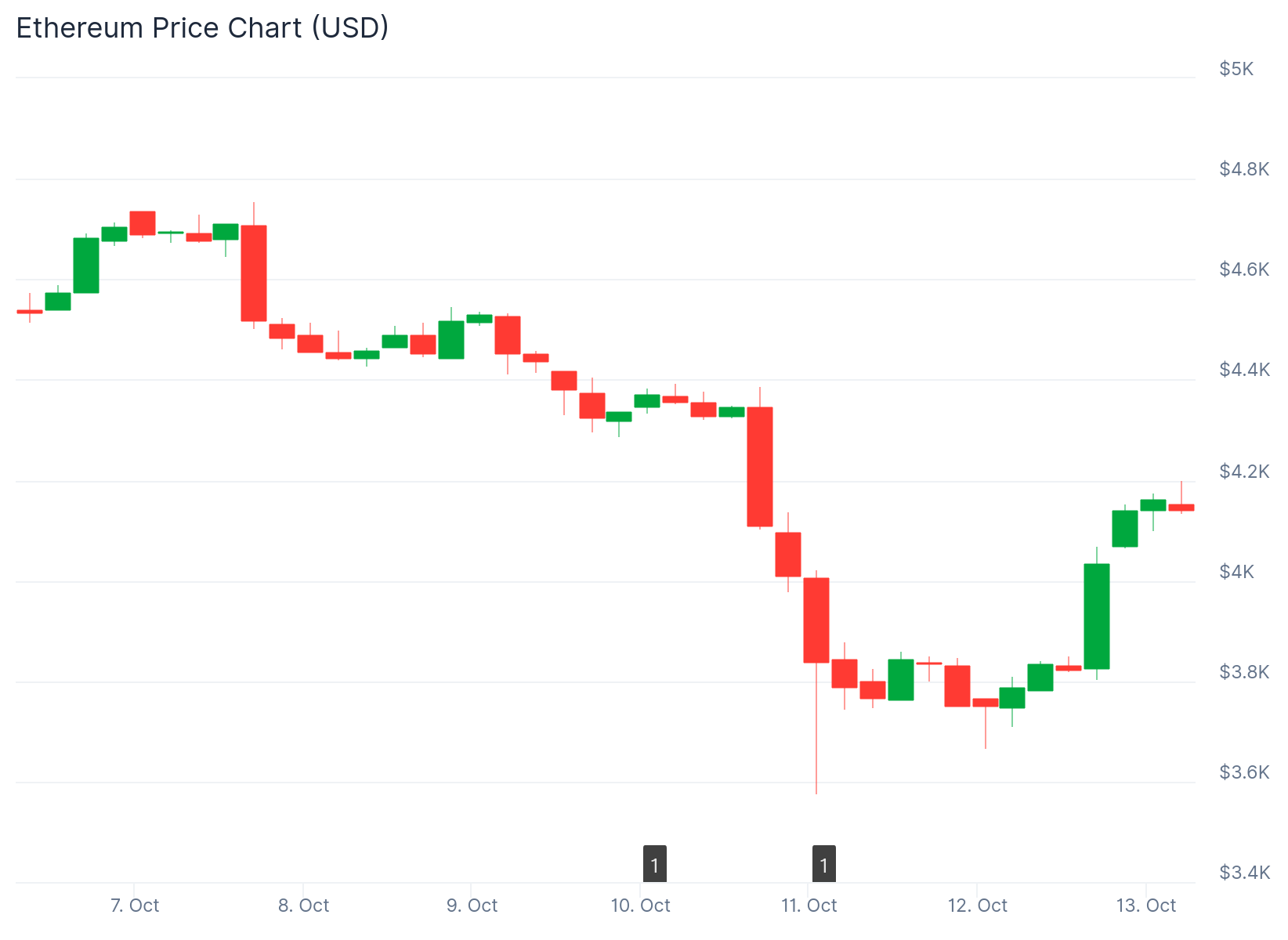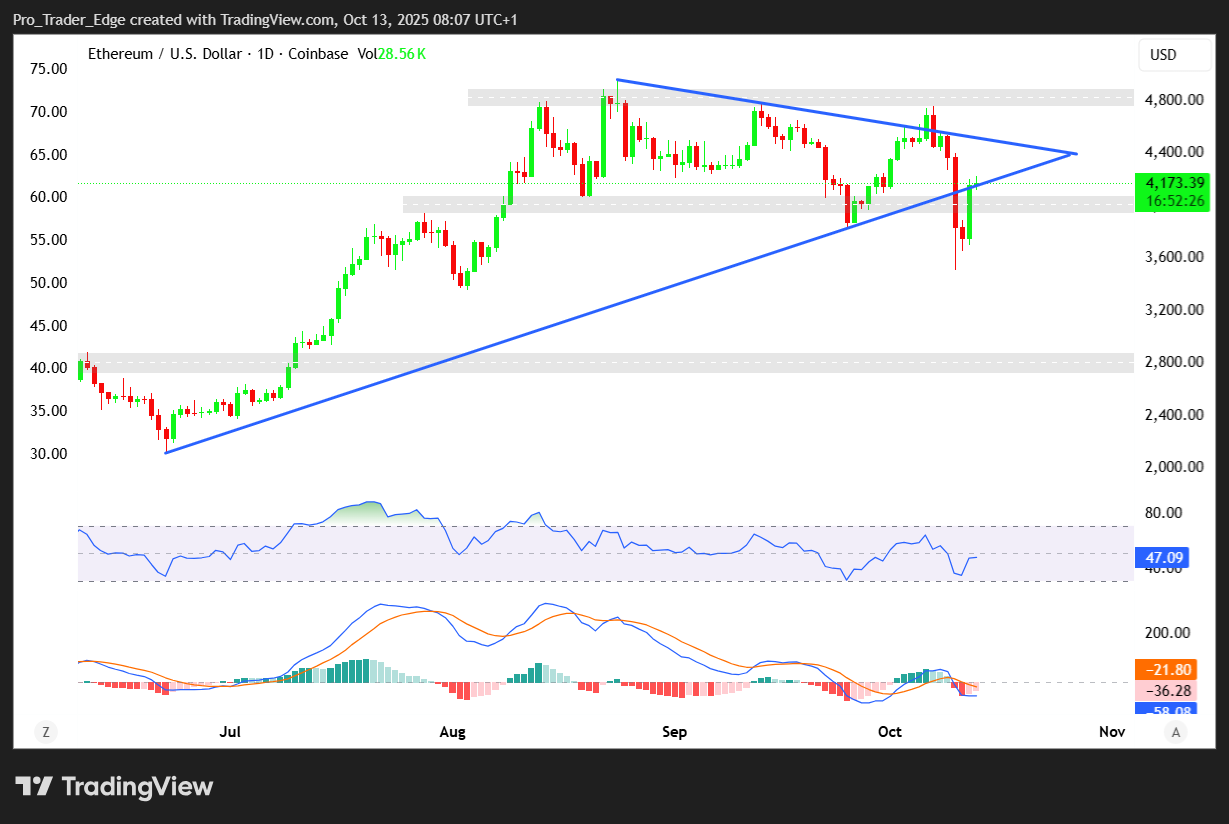TLDR
- Ethereum price recovered to $4,100 after dropping 20.7% in a flash crash that liquidated $3.82 billion in leveraged positions
- President Trump announced 100% tariffs on Chinese imports effective November 1, triggering risk-off sentiment across markets
- ETH futures markets normalized within two hours, with monthly futures regaining the 5% premium needed for neutral conditions
- Ether outperformed most altcoins during the crash, falling only 5% in 48 hours while competitors dropped 10% or more
- Options markets remained balanced with no unusual demand for bearish strategies, indicating healthy derivative conditions
Ethereum price returned above $4,100 on Sunday after a sharp weekend selloff. The recovery came after ETH dropped to $3,750 support levels on Friday.

The crash liquidated $3.82 billion in leveraged long positions. This event left marks on ETH derivative markets that traders are still processing.
The selloff began after President Donald Trump confirmed 100% tariffs on Chinese imports. The tariffs will take effect on November 1, 2025.
From October 6 to October 10 (ET), spot Bitcoin ETFs saw a net weekly inflow of $2.71 billion, with BlackRock’s IBIT leading the pack with $2.63 billion. Spot Ethereum ETFs recorded a net weekly inflow of $488 million, led by BlackRock’s ETHA with $638 million.… pic.twitter.com/gYdBrbPzON
— Wu Blockchain (@WuBlockchain) October 13, 2025
The announcement triggered risk-off sentiment across traditional and digital asset markets. Sellers pushed ETH below the 50-day moving average near $4,400.
Price dropped through multiple support levels during peak volatility. The $4,350 zone failed first, followed by the $3,800 consolidation band.
Funding rates on ETH perpetual futures fell to negative 14%. This meant short traders were paying to maintain their positions.
Such conditions typically reflect fears about market maker or exchange solvency. These concerns may have merit or may be overblown.
Derivative Markets Show Signs of Recovery
Monthly futures markets absorbed the shock in less than two hours. They quickly regained the minimum 5% premium required for neutral market conditions.
The lack of demand for leveraged long positions in perpetual contracts likely reflects product design issues. This distortion should not be viewed as bearish for ETH momentum.
Binance announced $283 million in compensation for affected traders. The exchange indicated other cases remain under review.
Wrapped tokens and synthetic stablecoins experienced the steepest losses. These assets caused trader margins to fall up to 50% within minutes.
Options markets on Deribit showed no signs of stress. Trading volumes remained normal over the weekend.
Activity in put options was slightly lower than call options. This signals a balanced and healthy derivatives market.
ETH Outperforms Competing Altcoins
Several major altcoins experienced deeper corrections than Ethereum. SUI dropped 84%, Avalanche fell 70%, and Cardano declined 66%.

Ether has fallen only 5% in the past 48 hours. Most competitors remain roughly 10% below their pre-crash levels.
This performance gap highlights the strength provided by institutional products. Ethereum has $23.5 billion in spot exchange-traded funds.
The options market holds $15.5 billion in open interest. These figures dwarf competing altcoins.
BNB, XRP, SOL, TRX, and DOGE all registered steep losses. Performance dispersion narrowed, suggesting a macro-driven shock.
Correlations across risk assets rose during the selloff. Equity futures declined as the tariff news spread.
The dollar strengthened while Treasury yields moved unevenly. These shifts signaled a classic flight to safety.
Stablecoin liquidity remained functional throughout the crisis. Spreads in major pairs held close to par after the initial shock.
On-chain flows showed exchange inflows climbing during the drawdown. Whale-size transfers appeared but suggested a broad set of sellers.
The $3,800 to $3,500 zone now forms an immediate decision area. A defense of this band could set up retests of $4,200 to $4,400.
ETH price currently trades above $4,000 as derivative markets continue to stabilize.






